|
|

|
Contemporary Collection
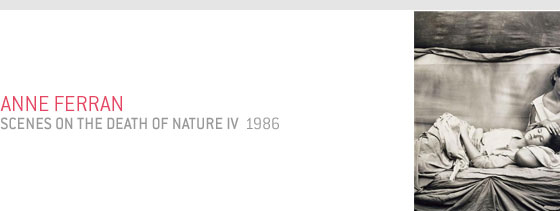 | Anne Ferran (born 1949)
Scenes on the Death of Nature IV 1986
gelatin silver photograph
148.5 x 109.5cm sight; 154.0 x 115.0cm frame
Hallmark Cards Australian Photography Collection Fund 1987 Ferran has said: ‘This work ought not need me as the artist to make pronouncements about its meaning. For one thing there is in it very little of a personal vision or private sensibility. In their size and scale, their period connotations, their employment of classical conventions, the photographs are … reminiscent of monumental sculpture which is, out of all art forms, the most public … It could be said of these photographs that the language they “speak” is so much a part of our culture that the audience already knows how to interpret them, even if it doesn’t “know” that it knows’.
Anne Ferran 1987 |
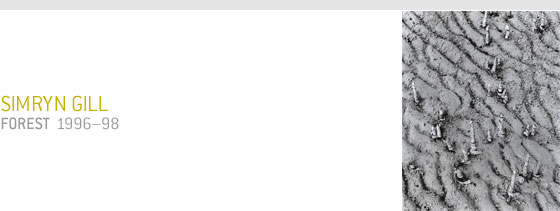 | Simryn Gill (born 1959)
Forest 1996–98
16 gelatin silver photographs
120.0 x 95.0cm each
Purchased with funds provided by the Art Gallery Society of New South Wales Contempo Group 2003 Through photographs, objects and installations Simryn Gill considers how we experience a sense of place and how both personal and cultural histories inform our present moment. Her work also suggests how culture becomes naturalised, an almost invisible part of our physical environment. Gill often works with books, narratives and texts that provide a framework through which we order and describe the world around us. Forest 1996-98, has the appearance of an etymological proposition where Gill quite literally takes printed words back to roots. Not their roots, as in the source of their meaning, but rather the growing, evolving, decaying nature from which the raw material for books is derived. The artist tore up the fibrous matter of pages from classics such as Frankenstein, The Origin of Species and Robinson Crusoe and grafted fragile strips of text into the natural environment. The original plant interventions occurred in places where a tamed nature was in the process of becoming wild again, in decrepit gardens and decaying buildings in Malaysia and Singapore. |
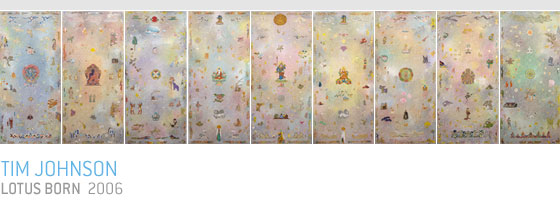 | Tim Johnson (born 1947)
Lotus born 2006
with Brendon Smith and Karma Phuntsok
synthetic polymer paint on canvas, 9 panels
9 panels: each 198.0 x 91.5cm; 198.0 x 823.5cm overall
left to right:
1. Medicine Buddha
2. Mandala
3. Dakini
4. Tsong Khapa
5. Padmasambhava
6. Shakyamuni
7. Rainbow body
8. Yantra
9. Wheel of law
Contemporary Collection Benefactors 2006
Tim Johnson traces connections he perceives as underlying artistic and spiritual practices across countries and cultures. Johnson began making art in the late 1960s and, along with Mike Parr and Peter Kennedy, was one of the founding members of the Sydney co-operative experimental art gallery Inhibodress, a catalyst for the development of conceptual and performance art in Australia. Later in the 1970s Johnson returned to painting and in 1980 visited the Western Desert, spending time at Papunya and working with senior Aboriginal artists. Concurrent with his study and experience of Western Desert painting, Johnson’s interest in Buddhism and Asian art developed as he explored early Chinese cave paintings, Tibetan and Japanese art, and American Indian art. Johnson’s iconography is a mix of cultural borrowings and imagery from his own richly inventive imagination. The title of this painting Lotus born is the translation from Sanskrit of the name Padmasambhava (Guru Rinpoche), a historical figure who is shown in the centre of Panel 5. A great adept, he brought Buddhism to Tibet. |
 | Anselm Kiefer (born 1945)
(Left to right) Myrtis painted bronze, lead 144 x 133 x 128 cm
Hypatia painted bronze, glass, iron, ash 202 x 118 x 117 cm
Candidia painted bronze, iron 177 x 130 x 125 cm
From the series Women of antiquity 2002 Born in 1945 in Donaueschingen, Germany, Anselm Kiefer is regarded as one of the most important and influential artists working today. Since the early 1970s his work has evolved from a formative interest in expressing the fascism of Germany to reflecting history through mythology, wide-ranging materials, and the language of iconography. A recurring interest in Kiefer’s recent work is the treatment many mythologies have handed out to women, particularly women whose strength and intelligence have been seen as unruly or cause for demonisation. In Women of antiquity, he portrays Candida, Myrtis and Hypatia, three women who came to a bad end by competing with men. Each is identified through a key attribute: a lead book in place of her head identifies Myrtis, a Greek poet blamed for competing with Pindar; a glass Melancholia cube represents Hypatia, an Alexandrine philosopher who was brutally murdered in sectarian unrest in 415 CE; and a rusting mass of razor wire signifies Candidia, a Roman witch who wove vipers through her dishevelled hair.
|
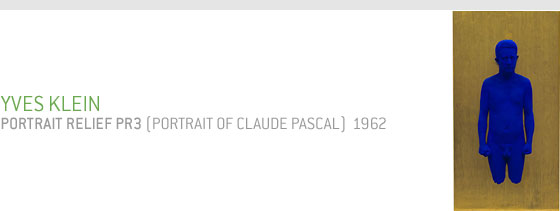 | Yves Klein (1928–62)
Portrait relief PR3 (portrait of Claude Pascal) 1962
dry pigment in synthetic resin on bronze mounted on primed and gold-leafed board
176.0 x 94.0 x 35.0cm overall
Purchased with assistance from the Mervyn Horton Bequest Fund 1990 By the middle of the 1950s, French artist Yves Klein had settled on ultramarine as the colour most expressive of spiritual potential, both private and cosmic. He patented a hue called International Klein Blue, using it in a series of works entitled the Anthropometries which were 'painted' with the bodies of living models. Klein’s most controversial act, a seminal example of performance art, was to leap 'into the void' from a second-storey window in Paris in 1960. In 1962 he began the project to record himself and his circle of intimates in a quartet of body casts. Portrait relief PR3 (portrait of Claude Pascal) belongs to this group, left incomplete at Klein’s death. This portrait of Claude Pascal is cast from the poet's body and coloured in International Klein Blue pigment. Seeming to levitate in front of its golden screen, the figure re-enacts Klein's leap into the void. Klein himself was to have been represented, conversely, in gold against blue, but died before making the cast. |
 | Jannis Kounellis (born 1936)
Untitled 1984/1987 1987 (detail below)
steel, wood, plaster, cloth, gas burner, paint, soot marks
201 x 1093 x 19.5cm (overall)
Mervyn Horton Bequest Fund 1988 In 1967 a number of artists in Rome formed the arte povera group, with Kounellis as one of the key members. Literally the name derived from their use of poor and often discarded industrial materials rather than the traditional use of expensive oil paint, bronze or marble. Kounellis' Untitled is one of his most important works and it includes many of the ideas that permeate his practice and arte povera as a whole. The burning gas flame on the left represents the transformative power of fire and has alchemical associations. The flame is attached to a bed frame: the place where we are conceived and born, where we dream, where we make love and with luck where we die. Next we find fragments of household furniture, a house beam and bundles of objects wrapped in grey blanket fabric, evoking travel and the domestic.
In the centre of the work is a matt black square, a direct reference to Kazimir Malevich, an artist Kounellis admires. According to the suprematists (a Russian avant-garde art movement) the black square contains opposites, suggesting the end of representation and at the same time a window onto infinity. The remainder of the panels are filled with orderly rows of shelves, above each of which is a sooty trace of fire. In the ancient port city of Piraeus (near Kounellis' birthplace) is a cemetery where oil lamps burn on each grave as a token of the passage of the spirit and it is reasonable to assume that this is the meaning Kounellis wants us to take from the work. |
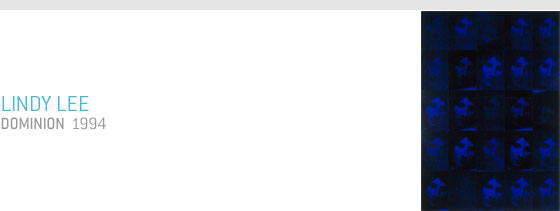 | Lindy Lee (born 1954)
Dominion 1994
synthetic polymer paint and photocopy on Stonehenge paper [25 panels]
200.5 x 143.0cm overall
Henry Salkauskas Art (Purchase) Award 1995 In the 1980s and 90s Lindy Lee was closely associated with appropriation practices, most simply (if reductively) identified as the use of images from other artists’ work. Lee’s best-know works from this period used photocopied portraits and faces from the ‘masterpieces’ of Renaissance art, overlaid with veils of paint. Through repeated copying and the inevitable degradation of the ‘original’ reproduction, faces emerge and submerge into inky blackness across multiple panels. This suggested both cultural distance from the iconic original works and our experience of them through ubiquitous reproductive technologies. Yet at the same time Lee’s work retained something of the aura of the original by showing just how much beauty could be retained in this repeated, copied and reworked state. In Dominion, the face from a Renaissance painting is toned blue and submerges into darkness in some panels to become an abstract monochrome. The near disappearance of the image recalls Lee’s interest in American mid 20th-century abstract painter Ad Reinhardt and the ambition of the modernist monochrome painters to erase representation. The grid is a key structuring device in Lee’s work enabling the development of visual ideas dependent on repetition and subtle change across the multiple panels. |
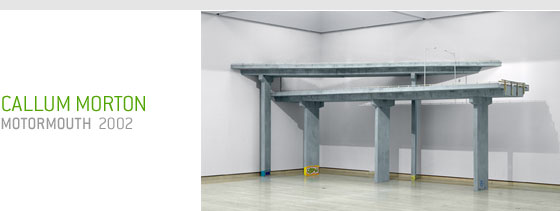 | Callum Morton (born 1965)
Motormouth 2002
polystyrene, wood, acrylic paint, impact resistant polyurethane, acrylic, sound dimensions variable
Contemporary Collection Benefactors 2002 Callum Morton’s sculptures combine incisive social observation, ideas about urban design and contemporary living, and an interest in the legacy of minimal sculpture. Motormouth continues his consideration of the intersections between public and private space and in particular the ‘non-spaces’ of urban design such as freeways, shopping centres, service stations, cinemas and convenience stores. These are the generic buildings and sites that are designed as transit zones between destinations or as backdrops to their intended function. We don’t usually notice their architecture except as an indicator of this function. Morton’s sculptural versions reintroduce narratives that are at odds with the social design of these places and yet are somehow entirely appropriate for the setting. Motormouth is a sculpture of two freeways, scaled 1:10 and perfect in detail down to the dirty realism of their distressed, water-stained concrete marked with graffiti. Designed to move people efficiently between city and suburb, home and work, board-room and bedroom, or at the very least to get you across town in time for your meeting, they are also a battleground where the tensions between private and public erupt. |
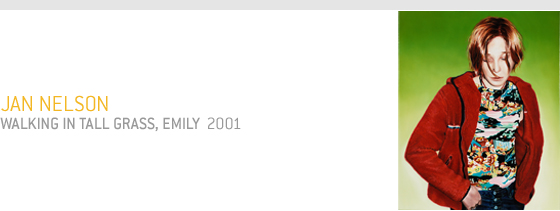 | Jan Nelson (born 1965)
Walking in tall grass, Emily 2001
oil on linen
81.5 x 66 cm
Contemporary Collection Benefactors 2004 Walking in tall grass, Emily is painted from a photograph rather than from life. Nelson has focused on the figure caught in an everyday moment and eliminated the background, echoing the Photoshop aesthetic of magazine images, which combine street-cred realism with digital manipulation. Nelson’s painting has removed ‘Emily’ from a particular social or physical environment and set her against a shaded monochromatic colour field. The figure is both isolated and highlighted by this act, a sense of isolation enhanced by the fact that Emily looks down, avoiding our gaze, seemingly caught in a moment of perhaps anxious reverie. While Walking in tall grass, Emily echoes the immediacy of the photographic instant, with ‘Emily’ caught seemingly unawares in a private moment, Nelson’s process is the slow-time, tactile and exacting medium of oil paint. Photography has become pervasive in how we experience visual identity, but Nelson’s work embeds the momentary into a far more considered process. This reflects the careful construction of image choices that many teenagers experience in the ‘groom and consume’ ethos of affluent youth culture. |
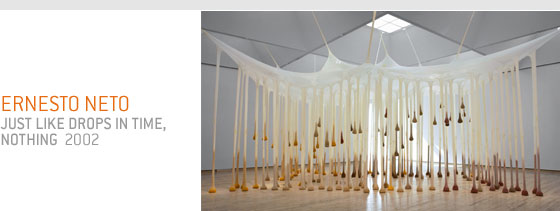 | Ernesto Neto (born 1964)
Just like drops in time, nothing 2002
textile, spices
dimensions variable
Purchased with assistance from Clayton Utz 2002 Through scale, form, smell and touch, Neto’s work invites us to experience a heightened awareness of our own sensing and feeling bodies. His installations stretch the membrane that separates art and life. Neto's use of transparent elastic fabric describes the tension of spaces he invades while anthropomorphising architecture. Vast masses of fragrant spice swell the fabric in voluptuous, almost bodily, forms that fill the gallery space and our olfactory organs with its aromatic intensity. Unlike vision, smell entails the physical invasion of the body by the scent's particles. In this way the sensations evoked by Neto's spice works are involuntary and almost instinctive. Just like drops in time, nothing has multiple associations, including rain capturing a ray of light or glancing through a forest, but it always refers back to the presence of the body, indicated by the bulging forms and even by the close association of Lycra with underwear or stockings. At the same time there is a sublime architectural allusion created by the curving translucent arches that articulate the whole room. |
 | Susan Norrie (born 1953)
Undertow 2002
6 channel video installation with sound, projection boxes
Purchased with funds provided by Clayton Utz 2003 Undertow is simultaneously an overwhelming and deeply meditative video installation, and is the culmination of several years of experimentation and development in Norrie’s art practice. Through projected and screen images, sound, and sculptural objects, the world is portrayed in a state of both beauty and corruption, shuddering with natural and unnatural events that verge on the catastrophic. The viewer is immersed in scenes of ominous tempests, delicate spring blossoms, bubbling mud pools, swirling clouds of dust, and scientific experiments which in the face of these phenomena seem futile and inadequate. A large projection of changing images dominates the exhibition space. A forest wreathed in haze recalls the sublime grandeur of paintings by German romantics such as Casper David Friedrich, but the haze is from chemical fires which envelop the trees. In another sequence the earth itself seems to smoke and burn. Despite the potential horror of some of the imagery, a dark compelling beauty animates Undertow. The gothic painterly quality of this work is underscored by an insistent and hypnotic sound track by Robert Hindley. |
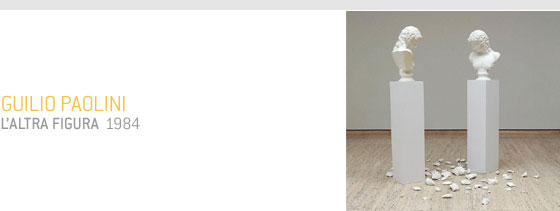 | Giulio Paolini (born 1940)
L'altra figura 1984
plaster, wood plinths
183.0 x 250.0 x 190.0cm overall
Mervyn Horton Bequest Fund 1987 L’altra figura (the other figure) is a deceptively simple play on a classical theme. The two heads raised on plinths to the height of a modestly sized viewer are identical plaster casts of a Roman copy of an earlier Hellenistic bust. The busts show the heads slightly at an angle to the body, their faces turned to reflect each other precisely. This slightly sideways glance lends a degree of animation to what would otherwise be a static mirroring. It is as if they have both just turned to catch the other’s gaze; perhaps it is the dramatic incident that has just occurred between them. On the floor surrounding the two plinths is the manifest evidence of a minor disaster. Another bust that seems to have crashed to the floor, shattering into multiple pieces of plaster, is just barely recognisable as the third of a kind. The twins may be thought of as a related pair or a mirroring of one, but three is the beginning of an indefinite number, suggesting infinite reproducibility or endless cloning. |
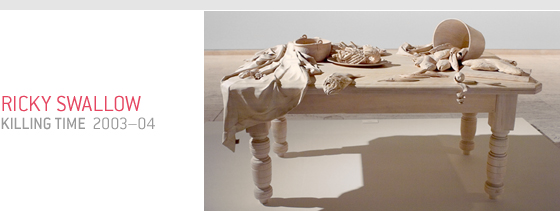 | Ricky Swallow (born 1974)
Killing time 2003-04 (detail below)
laminated jelutong, maple
108 x 184 x 118 cm (irreg)
Rudy Komon Memorial Fund and the Contemporary Collection Benefactors 2004 In Killing time Ricky Swallow has synthesised his interests in time passing, personal and collective memory, everyday experiences and the history of art. The centrepiece of Swallow’s solo exhibition at the Australian Pavilion in the 2005 Venice Biennale, it is his most ambitious work to date. While Killing time visually recalls 17th-century Dutch still-life painting and even the work of such a virtuoso illusionist woodcarver as Grinling Gibbons, the subject matter is derived from Swallow’s personal experience. The son of a fisherman, Swallow has faithfully depicted every sea creature that he recalls capturing, killing and eating with his father. The various fish, lobsters, oysters, crabs and others are displayed on a table which duplicates the table around which Swallow’s family ate dinner every night. While Killing time uses the visual language of a particular genre of painting and woodcarving, it is also an intensely personal act of remembering; it is another ‘evaporated self-portrait’ as Swallow has described his sculptures, which call on specific personal memories while also having a commonly recognisable subject matter. |
|
|